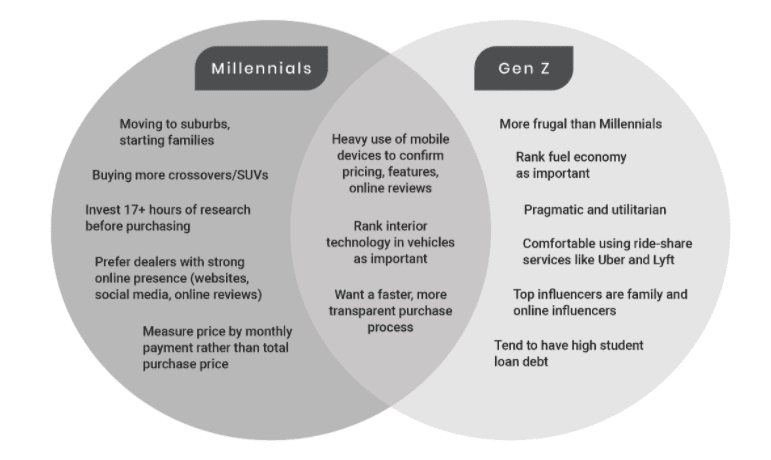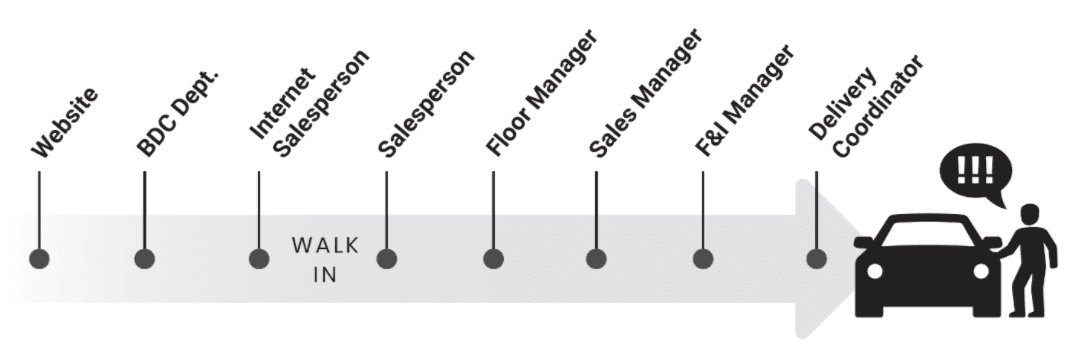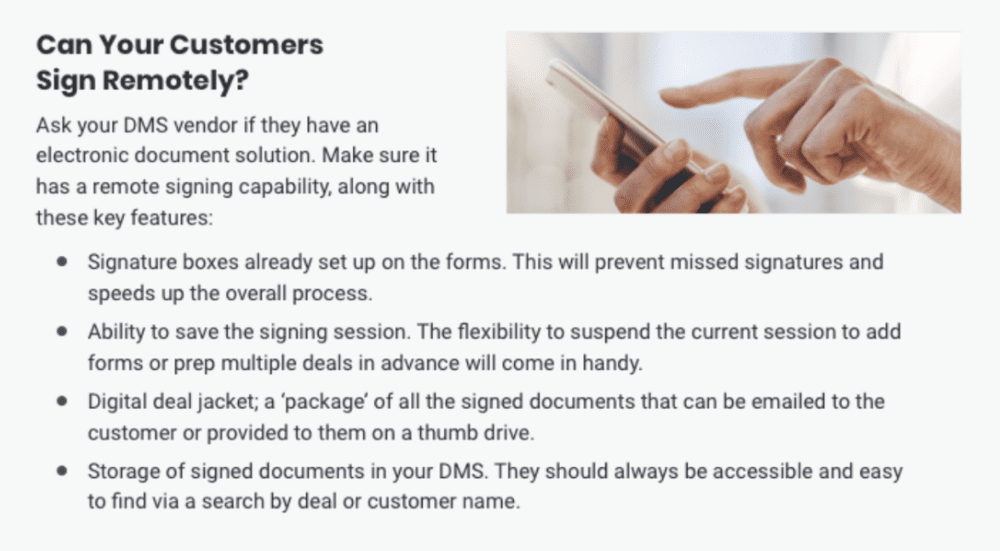Projections for U.S. light-vehicle sales in the next five years are optimistic, according to research shop Benchmark Co. By 2025, there will be a record 245 million licensed drivers in the United States, with current demographics supporting 16.5-17 million vehicle sales annually over the next 5-10 years.
But rosy predictions don’t mean that car dealers should become complacent. Expectations of modern car buyers are changing. Dealerships that retain outdated sales processes risk losing car shoppers to competition that has adopted a more customer-centric approach.
According to Deloitte’s Global Automotive Consumer Study, 78% of surveyed consumers rate the customer experience as a “somewhat important” or “very important” factor in choosing where to buy a vehicle. However, in many dealerships, long-standing issues detract from the experience. Survey respondents cited the following aspects of the purchasing process in dealerships that they don’t like:
To win business and build loyalty with today’s car buyers, dealerships will need to update their sales process to align with modern expectations.
Section One: Who is the Modern Car Buyer?
Millennials have often been portrayed as being uninterested in buying cars, but as a group, that’s changed in recent years as their lifestyle has changed. As Millennials get married, buy homes and start families, they need reliable transportation.
Millennials currently represent approximately 40% of the new-vehicle market and make up the fastest growing segment of vehicle buyers, according to J.D. Power’s Power Information Network (PIN). Additionally, Millennials’ share of U.S. retail new-vehicle sales has risen about 9% annually since 2011.
Another demographic group buying cars in greater numbers is Generation Z, born after 1996. This generation is entering the workforce in the tens of millions armed with $3 trillion in purchasing power, according to Automotive News.
Although both the Gen Z and Millennial generations have vehicle preferences that are unique to their generations, as they grow older those preferences will change as their needs change. However, their shopping behaviors and expectations for a customer-focused experience are unlikely to change.
Section Two: Align Your Sales Process to Expectations
Follow these steps to optimize your dealership’s sales process.
Step 1: Invest in Digital Retail Tools
Before the spread of COVID-19, just 32% of car buyers said they were open to buying online, but now 61% are open to this idea, according to CarGurus’ COVID-19 Sentiment Study.
To meet car-buyer expectations, many dealers are investing in digital retailing tools. This trend is likely to continue. Whether your dealership has adopted an end-to-end solution that enables the entire purchase online or is offering a hybrid approach that allows buyers to complete just some of the steps online, it’s important to provide a seamless transition from online to showroom.


Tips for Choosing a Digital Retail Solution
- Provide customers with the ability to save deals and return to them later, whether online or in the showroom. Nothing is more frustrating for consumers than being asked the same questions or having to repeat tasks.
- Allow consumers to configure their own deal, including payments online
- Commit to transparency. Customers need to know the price before moving on to finance
- Ensure tools are integrated with your CRM and website. Integrated solutions speed up the purchase process and reduce mistakes related to manual entry errors.
- Choose a solution that calculates precise pricing, incorporating the customer’s credit score, and local taxes and fees
- Allow consumers to view online F&I product presentations and choose their own aftermarket products.
- Bolster marketing campaigns with invaluable customer data to ensure customers return for routine service and target those in a good position to trade
The adoption of digital retailing has accelerated due to COVID-19. Going forward, most consumers will want to complete the majority of the purchase process online. To engage and convert website visitors, choose a digital retail solution that’s easy to use and puts the buyer in control of their own vehicle-purchase process.
What About the Back End?
A popular misconception is that digital retailing assists only the front end of the dealership. This is false. Digital retailing doesn’t end with vehicle purchases. A complete digital retail platform possesses CRM and equity mining tools that leverage insightful data to engage customers via their preferred communication channel to get them to return for service.
Not only does equity mining help ensure additional service revenue, it helps identify the best opportunities to hand service customers over to sales to re-enter the sales cycle.
Step 2: Streamline the Finance Process
Americans wait an average of 75 hours every year at the DMV, doctor’s offices, and in grocery store checkout lines. The last thing they want to do when buying a car is wait even more. Don’t lose your customer in a pile of slow-moving paperwork.
A typical car buyer deals with at least three people during the purchase process. In some dealerships, that number can be as high as eight. For example, a car shopper might communicate with a BDC agent, an Internet salesperson, a salesperson, a floor manager, a sales manager, the F&I manager, and a delivery coordinator — all just to complete one transaction.
Your first goal should be to reduce the number of employees involved in a vehicle purchase to two or less. The sales consultant is the natural point person.
Next, aim to reduce the amount of time it takes to buy a car. According to Autotrader.com, the average CSI score drops after a consumer spends longer than 90 minutes at the dealership. Therefore, aim for a purchase process that’s 90 minutes or less.
Use technology to help reduce customer wait times. Benefits of digitizing your F&I process include an expedited purchase process, increased transparency and elimination of waste associated with printed paper.
Tools to Digitize the F&I Process
- Mobile CRM to seamlessly transition customers from online to the showroom
- Mobile valuation tools
- Digital F&I menu that has video presentations of products and allows the customer to take a needs-discovery survey while they’re waiting for the F&I manager
- Electronic signature capture and laser forms that can be electronically signed and stored within the deal
The above tools require mobile tablets to implement and use. Tablets are a great way to introduce new technology into the dealership since they are relatively inexpensive and most employees are familiar with the technology.
In addition to digitizing your in-showroom F&I experience, it’s important to offer remote signing capabilities for customers who don’t prefer to finalize the deal in your dealership’s showroom.
Step 3: Document a Customer-Centric Process
In many dealerships, the sales process hasn’t significantly changed. Managers and salespeople alike are sometimes resistant to change processes that have worked for them for years.
However, your process may need to change to match modern buyers’ expectations. By the time today’s car shoppers arrive in the showroom, many have already chosen a vehicle, figured out financing, and are minutes away from closing. There’s no need to put them through the qualifying process or subject them to a sales pitch.
To create a customer-centric process, start by mapping your customer journey. Make it a group project and ask for input from your sales team. Use a whiteboard and erasable marker. Be specific about who should handle leads, how they should be handled, and what customer expectations are at every step. Ensure that your sales process is designed to meet customer expectations vs. what’s easy or convenient for your sales team and managers.
Once the process is perfected, document it and create a training booklet for new employees. If a process isn’t documented in writing, every employee will do it differently.
Step 4: Reconsider Staff Roles/Responsibilities
Modern car buyer expectations are changing the roles and responsibilities associated with dealership salespeople, F&I managers, and BDC agents. Today’s informed buyers need nurturing and assistance, not just closing.
Many dealers are experimenting with different options. Some dealers are creating a concierge-type position, where the person presenting the vehicle is a product specialist and takes on a consultative role. Then a manager handles every aspect of closing the deal, including F&I. BDC agents may need to be trained to facilitate a remote or online car-buying process.
The good news for dealers is that rethinking staff roles can create more hiring opportunities. Many dealers are challenged by high turnover rates in the sales department and have trouble finding experienced salespeople.
The modern car-buying process requires the ability to use and understand technology, provide good customer service, and strong communications skills. That
It’s very likely several new staffing models will emerge as viable, and which one you choose will depend upon how closely it adheres to your desired sales process. Keep in mind that the way your salespeople approach and communicate with online customers is very different than how they interact with a showroom up.
Step 5: Train Staff
The key to developing a successful customer-focused sales process is training. Modern car buyers do their research, so it’s critical that your sales staff are knowledgeable about your product line. When your staff members can’t answer a customer’s question, they risk losing that customer’s respect. Make sure your sales staff knows all the specs and features associated with every make/model.
Additionally, train staff on how to use an omnichannel communications approach with customers. Car buyers want to communicate with your staff via their preferred method, whether that’s phone, email, text, or other messaging applications. Whether for lead follow-up purposes or every-day communications, it’s important your staff know how to walk the fine line between being persistent and friendly but not intrusive.
Last but not least, staff should receive customer service training. Numerous online customer service training programs are available and have proven to deliver the following benefits.
- Improved employee motivation & self-confidence
- Drop in employee turnover rates
- Increased customer satisfaction
- Increased revenues
Pro Tip: Develop a list of customer FAQs for all customer-facing employees. This ensures that car buyers’ most commonly asked questions are immediately answered when they come in through various channels.
Today’s car shoppers demand a customer experience that’s fast, transparent, and focused on their needs, rather than what’s convenient for dealership staff. Building loyalty with tech-savvy Millennials and Gen Z requires investing in technology solutions that make the car-buying process convenient and create a customer-centric sales process.
Did you enjoy this article from Anthony Mitchell? Read other articles on CBT News here. Please share your thoughts, comments, or questions regarding this topic at newsroom@cbtnews.com.
Be sure to follow us on Facebook and Twitter to stay up to date or catch-up on all of our podcasts on demand.

While you’re here, don’t forget to subscribe to our email newsletter for all the latest auto industry news from CBT News.













